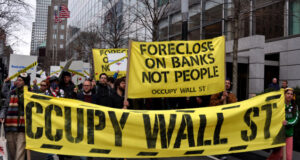This post is part of a series of posts that summarizes the book Angrynomics by Eric Lonergan and Mark Blyth.
If you found this post via search, it probably makes sense to start with the link to the full series, which is both here, and above.
Table of Contents
Angrynomics: There seems to be a pattern here
This pattern is being seen all over the world, independent of how a government claims their politics and economics are organized.
This pattern is being seen in the USA, Europe, Chile, Brazil, Philippines, China, etc.
Governments bail out big banks and big businesses through their central banks.
Even after economic calamity, elites gather and shelter wealth.
Governments do little to nothing to help Main St businesses and people.
Some governments impose austerity that hurts poor and middle-class people.
And people are getting angry
All over the world, people are starting to express anger about how their leaders seem to be clearly favouring big business over people.
2009: The Tea Party in the USA
After Wall St investment banks, GM, and other big businesses got bailed out, the Tea Party formed and started protesting.
They opposed excessive taxation and government intervention in the private sector while supporting stronger immigration controls.
They seemed to operate under the belief that their tax dollars were used to bail out the big businesses, and while taxes do not fund the US federal government, that is incidental to the big picture here.
The Tea Party movement was generally seen as right-wing anger at widespread economic mismanagement of the economy.
2011: The Occupy Movement
The Occupy Movement was perhaps the left-wing equivalent of the Tea Party.
Their dominant slogan became “We are the 99%” and they too were protesting what they saw as widespread economic mismanagement of the economy, but they called it fraud.
2016: Brexit vote
If ever there was a vote of “F*** YOU!”, it was Brexit.
The UK had the best of both worlds with their EU membership. They had direct access to the largest trading block on earth AND direct control over a sovereign currency.
Yet when the UK government held a national referendum, a majority of UK voters voted to leave.
Why? I’m not sure I’ll ever understand for sure, but I do know they were angry at their political leaders, who had clearly been lying to them about the relationship between global trade and widespread economic prosperity.
2016: Election of Donald Trump
I recall a video from 2016 of Senator John McCain expressing surprise that some voters he spoke to said their first choice for President was Bernie Sanders and their second choice was Donald Trump. I looked for the video to include in this post, but could not find it.
McCain had a hard time wrapping his mind around the idea that Bernie Sanders and Donald Trump have anything in common, as to him, those two candidates represented opposite ends of the political spectrum.
I think what McCain failed to understand is both Sanders and Trump were seen as political outsiders (despite Sanders long history in politics),
People were (and still are) tired of hearing politicians lie, and they perceived that both Sanders and Trump were not like the other candidates and that alone made them viable choices.
2016: Iceland protests about the Panama Papers
Of the protests I mention in this blog post series, these Icelandic protests are my personal favourite.
Even though the Icelandic government handled the global financial crisis probably better than any other country, and kept the subsequent suffering to a minimum, when it was revealed that the economic elites of Iceland were sheltering assets in offshore shell companies, the proverbial s*** hit the fan, and quickly.
The Prime Minister of Iceland in fact became the first political casualty of the Panama Papers when he stepped down shortly after the protests started.
And ironically, while he was the first political casualty, it doesn’t seem that in his case there was an attempt to avoid paying taxes. The investment they sheltered was an inheritance received by his wife from her father, was publically declared, and taxes were paid.
But housing the assets in an offshore shell company certainly looked bad.
2018: The yellow vest protests in Paris
The Yellow Vest protests in France started after the French government increased a gas tax to increase government revenues (unlike the USA, France does not have a sovereign currency, so taxes DO fund federal government expenses).
The problem with the gas tax is it disproportionally hurt people who worked in Paris but couldn’t afford to live in Paris.
Which people saw as unfair.



